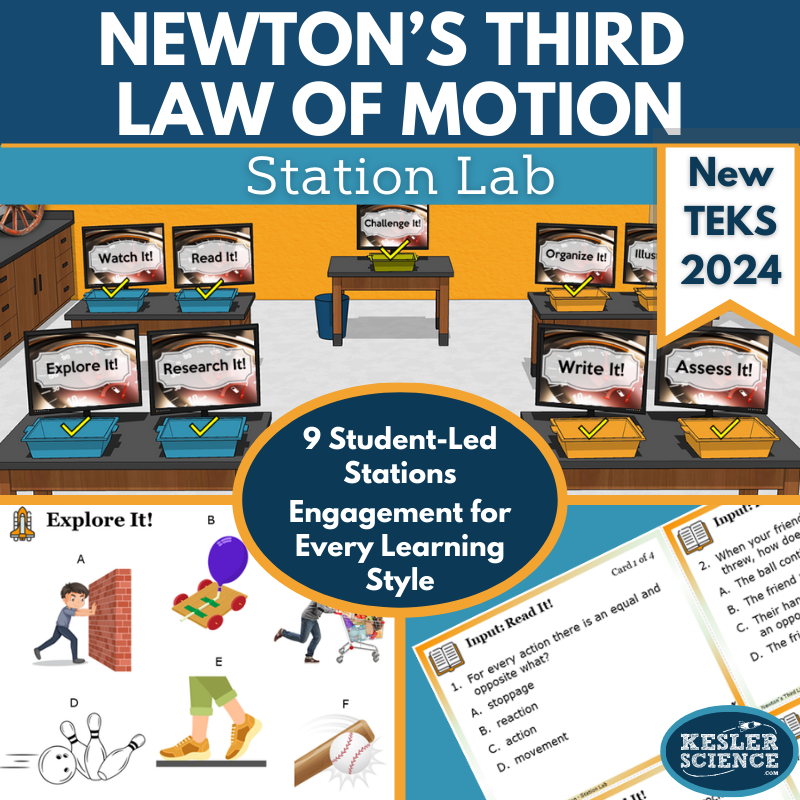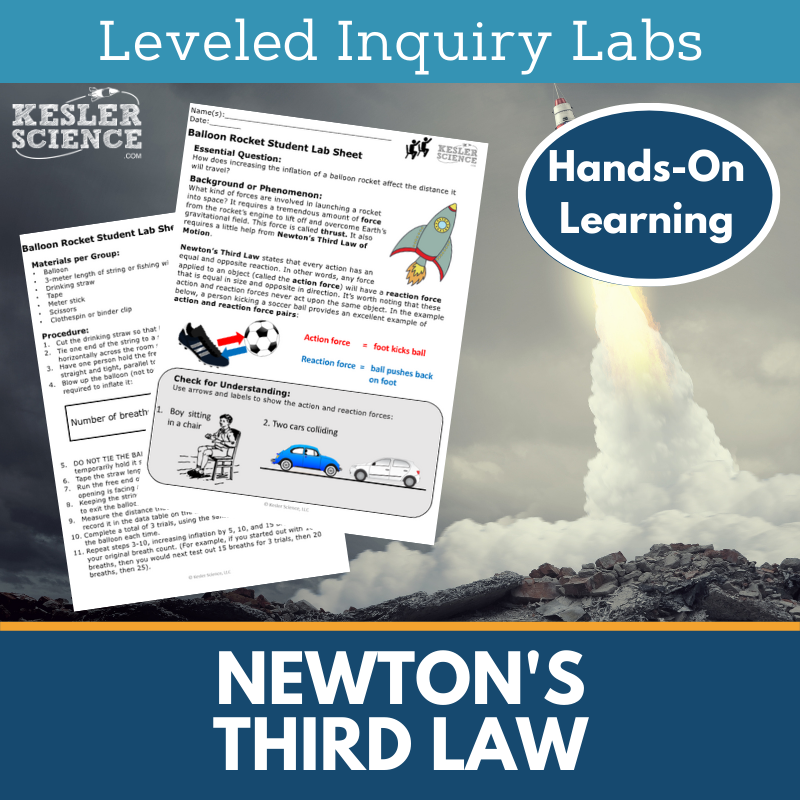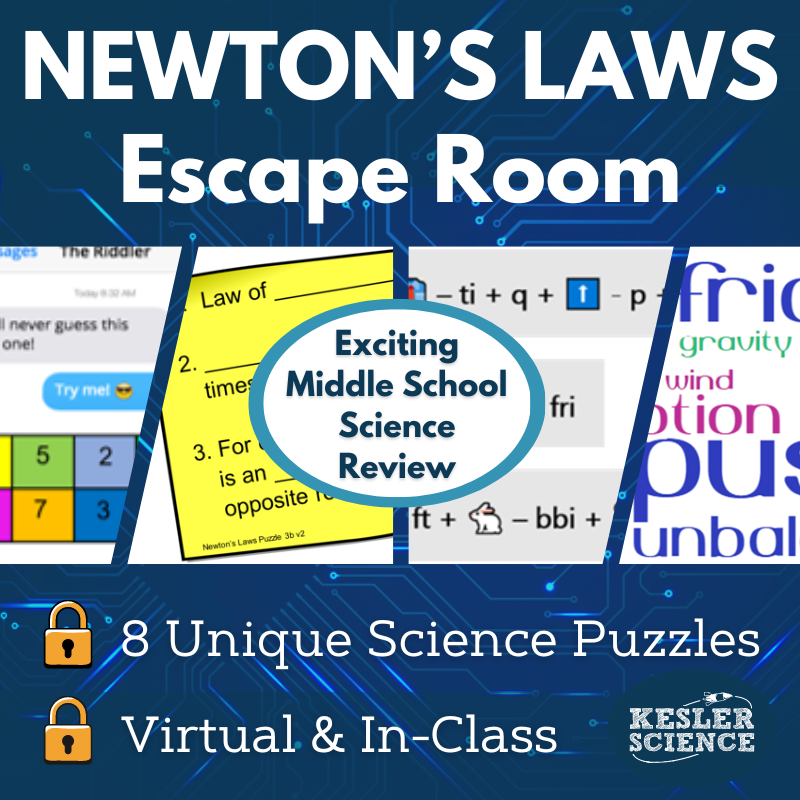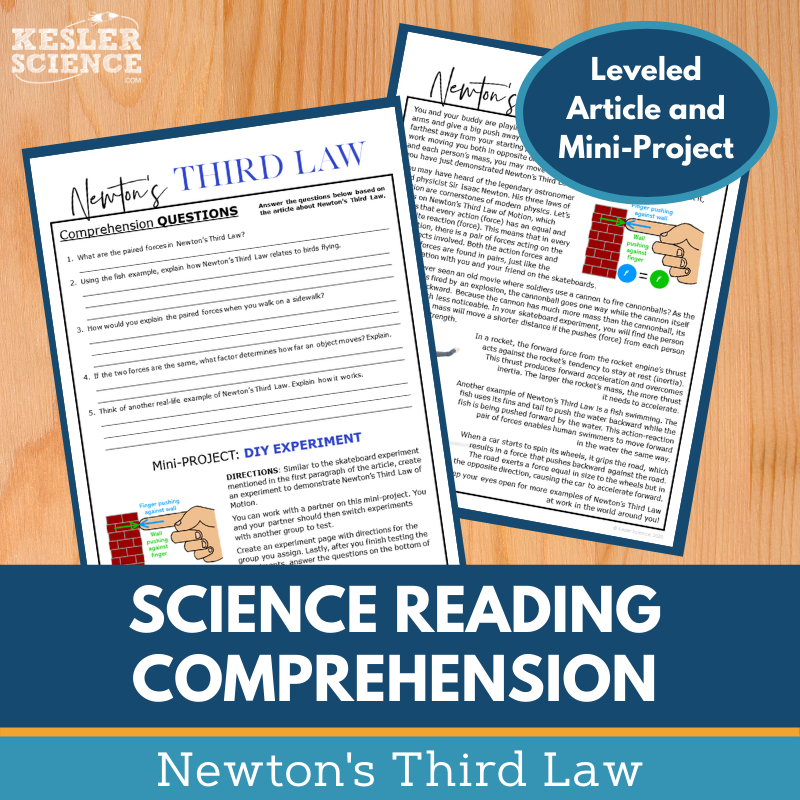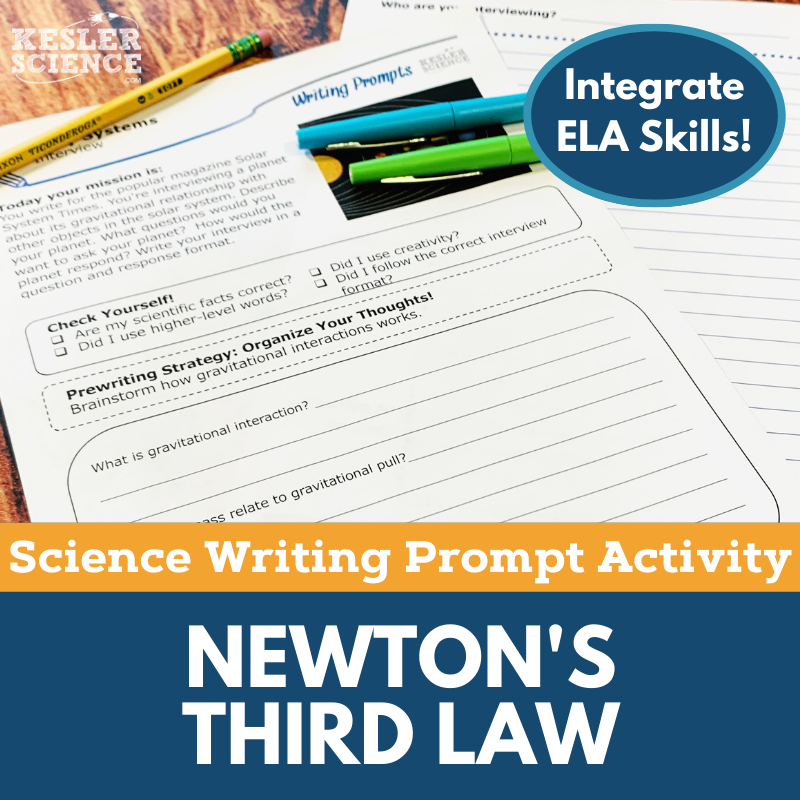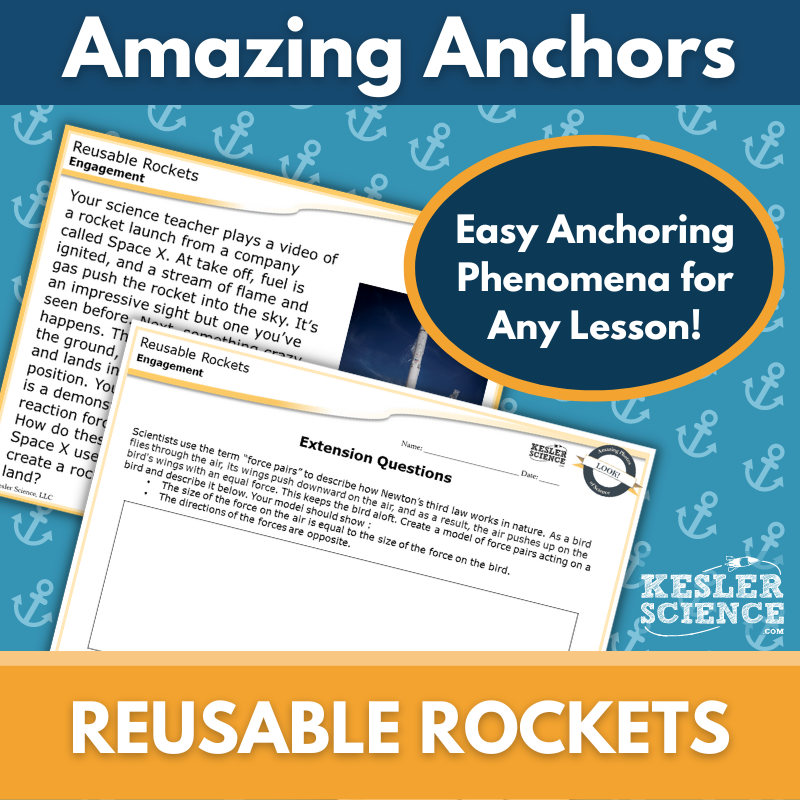Newton's Third Law of Motion Activities for Middle School Science
This engaging 5E lesson on Newton’s third law helps students understand force pairs that are equal in magnitude and opposite in direction. The resources below will give students a comprehensive understanding of Newton's third law of motion. All of the following materials are also included in the Kesler Science Membership.
The Kesler Science Newton's Third Law of Motion 5E Lesson is a comprehensive unit on Newton’s third law, helping students identify force pairs that are equal in magnitude and opposite in direction. It includes editable presentations, worksheets, assessments, and student-choice projects designed for differentiated, student-led learning with minimal prep. The lesson aligns with the 2021 TEKS 6.7C standard and supports multimodal learning in both print and digital formats.
Students engage with vocabulary resources, discussions, and activities before exploring the concept through a differentiated station lab. The lab includes hands-on experiments, reading passages in English and Spanish, research tasks, videos, and multiple ways for students to demonstrate understanding, such as writing, illustrating, and organizing concepts. A challenge station provides extension activities.
Explanation materials feature editable PowerPoints, interactive notebooks, and note-taking templates. Students elaborate through choice projects that reinforce Newton’s third law, while evaluation includes STAAR 2.0-aligned assessments, review questions, and worksheets. The lesson is adaptable for in-class or virtual learning, ensuring accessibility for all students.
The Kesler Science Newton's Third Law of Motion 5E Lesson is a comprehensive unit on Newton’s third law, helping students identify force pairs that are equal in magnitude and opposite in direction. It includes editable presentations, worksheets, assessments, and student-choice projects designed for differentiated, student-led learning with minimal prep. The lesson aligns with the 2021 TEKS 6.7C standard and supports multimodal learning in both print and digital formats.
Students engage with vocabulary resources, discussions, and activities before exploring the concept through a differentiated station lab. The lab includes hands-on experiments, reading passages in English and Spanish, research tasks, videos, and multiple ways for students to demonstrate understanding, such as writing, illustrating, and organizing concepts. A challenge station provides extension activities.
Explanation materials feature editable PowerPoints, interactive notebooks, and note-taking templates. Students elaborate through choice projects that reinforce Newton’s third law, while evaluation includes STAAR 2.0-aligned assessments, review questions, and worksheets. The lesson is adaptable for in-class or virtual learning, ensuring accessibility for all students.
Engage your middle school students with this student-led station lab aligned to the 2021 TEKS 6.7C standard. Designed for in-class or virtual learning, this interactive lesson guides students in identifying force pairs that are equal in magnitude and opposite in direction using Newton’s third law of motion.
Students explore concepts through nine differentiated stations featuring videos, readings, research, and hands-on tasks. They demonstrate their learning by organizing information, illustrating models, writing responses, and completing assessments. A bonus challenge station offers extension activities, and English and Spanish reading passages support differentiated learning.
This low-prep, high-engagement resource promotes active learning and critical thinking.
Engage your middle school students with this student-led station lab aligned to the 2021 TEKS 6.7C standard. Designed for in-class or virtual learning, this interactive lesson guides students in identifying force pairs that are equal in magnitude and opposite in direction using Newton’s third law of motion.
Students explore concepts through nine differentiated stations featuring videos, readings, research, and hands-on tasks. They demonstrate their learning by organizing information, illustrating models, writing responses, and completing assessments. A bonus challenge station offers extension activities, and English and Spanish reading passages support differentiated learning.
This low-prep, high-engagement resource promotes active learning and critical thinking.
The Newton’s Third Law of Motion Student Choice Projects align with the 2021 TEKS standard 6.7C, offering middle school students a variety of ways to demonstrate their understanding. A project page outlines six student-led options plus a “design your own” project, all with an editable rubric for teacher, peer, or self-assessment. This resource is also included in the Newton’s Third Law of Motion Complete Lesson for TEKS 6.7C.
These flexible, multimodal projects allow for creative expression and differentiation. Two versions of the project page support diverse learning needs, with modified options for students requiring remediation and challenge options for advanced learners. Teachers can adjust the rubric to fit their grading criteria.
The projects utilize common classroom supplies such as paper, markers, and scissors, with many options available for digital completion.
The Newton’s Third Law of Motion Student Choice Projects align with the 2021 TEKS standard 6.7C, offering middle school students a variety of ways to demonstrate their understanding. A project page outlines six student-led options plus a “design your own” project, all with an editable rubric for teacher, peer, or self-assessment. This resource is also included in the Newton’s Third Law of Motion Complete Lesson for TEKS 6.7C.
These flexible, multimodal projects allow for creative expression and differentiation. Two versions of the project page support diverse learning needs, with modified options for students requiring remediation and challenge options for advanced learners. Teachers can adjust the rubric to fit their grading criteria.
The projects utilize common classroom supplies such as paper, markers, and scissors, with many options available for digital completion.
The Newton’s Third Law Inquiry Lab aligns with TEKS, guiding students in investigating Newton’s third law of motion by constructing balloon rockets that race along a taut string or fishing line. This resource includes three differentiated labs designed to accommodate various learning needs.
The dependent student lab provides a mix of procedural instructions and inquiry questions for on-level learners. The modified student lab offers a structured experience with sentence stems and multiple-choice questions for students requiring additional support. The independent student lab encourages advanced learners to take full responsibility for their investigations with minimal guidance.
Students engage in hands-on exploration using common classroom materials such as balloons, string, drinking straws, tape, and scissors. Reflection questions prompt students to develop claim, evidence, and reasoning statements. Editable teacher resource pages and answer keys simplify lesson planning and assessment.
The Newton’s Third Law Inquiry Lab aligns with TEKS, guiding students in investigating Newton’s third law of motion by constructing balloon rockets that race along a taut string or fishing line. This resource includes three differentiated labs designed to accommodate various learning needs.
The dependent student lab provides a mix of procedural instructions and inquiry questions for on-level learners. The modified student lab offers a structured experience with sentence stems and multiple-choice questions for students requiring additional support. The independent student lab encourages advanced learners to take full responsibility for their investigations with minimal guidance.
Students engage in hands-on exploration using common classroom materials such as balloons, string, drinking straws, tape, and scissors. Reflection questions prompt students to develop claim, evidence, and reasoning statements. Editable teacher resource pages and answer keys simplify lesson planning and assessment.
The Newton’s Laws Escape Room is an interactive and engaging activity that immerses students in applying Newton’s three laws of motion to real-world scenarios. Designed to align with NGSS and TEKS, this escape room challenges students to think critically while reinforcing key vocabulary such as inertia, force, mass, acceleration, and friction. With eight independent puzzles, teachers have full control over which challenges to use, making it adaptable for different class periods and student needs.
This escape room can be conducted using simple materials like manila envelopes or a more immersive setup with locks, a storage box, and Scrabble pieces. Printable versions of all materials are included, allowing for easy classroom implementation. A digital version is also available, where students can complete the activity through PowerPoint or Google Slides. A printable at-home option ensures accessibility for all learning environments while maintaining copyright restrictions for classroom use.
The resource includes everything needed for a seamless experience, such as teacher directions, a detailed answer key, a digital answer sheet via Google Forms, and a video challenge to set the stage. Students will work through engaging puzzles with printable props while earning rewards and celebrating their success with themed signs. This hands-on learning experience keeps students engaged and talking about Newton’s laws long after the challenge ends.
The Newton’s Laws Escape Room is an interactive and engaging activity that immerses students in applying Newton’s three laws of motion to real-world scenarios. Designed to align with NGSS and TEKS, this escape room challenges students to think critically while reinforcing key vocabulary such as inertia, force, mass, acceleration, and friction. With eight independent puzzles, teachers have full control over which challenges to use, making it adaptable for different class periods and student needs.
This escape room can be conducted using simple materials like manila envelopes or a more immersive setup with locks, a storage box, and Scrabble pieces. Printable versions of all materials are included, allowing for easy classroom implementation. A digital version is also available, where students can complete the activity through PowerPoint or Google Slides. A printable at-home option ensures accessibility for all learning environments while maintaining copyright restrictions for classroom use.
The resource includes everything needed for a seamless experience, such as teacher directions, a detailed answer key, a digital answer sheet via Google Forms, and a video challenge to set the stage. Students will work through engaging puzzles with printable props while earning rewards and celebrating their success with themed signs. This hands-on learning experience keeps students engaged and talking about Newton’s laws long after the challenge ends.
This Newton’s Third Law Science Reading Comprehension Lesson helps students explore applications of Newton’s three laws through a nonfiction article, comprehension questions, and a hands-on experiment. Designed for middle school students, the leveled passage supports science literacy and reading comprehension.
The resource includes two Lexile-leveled articles (1100-1300), five to seven comprehension questions, and a hands-on mini-project. A Cornell notes template is provided for student support. The reading passage is available in print and digital formats for use in both in-person and virtual learning environments, including Google Classroom, MS Teams, Schoology, and Canvas.
Ideal for absent students, ISS, extra credit, sub plans, or whole-class instruction, this resource fosters critical thinking, classroom discussions, and textual analysis while reinforcing Newton’s third law concepts.
This Newton’s Third Law Science Reading Comprehension Lesson helps students explore applications of Newton’s three laws through a nonfiction article, comprehension questions, and a hands-on experiment. Designed for middle school students, the leveled passage supports science literacy and reading comprehension.
The resource includes two Lexile-leveled articles (1100-1300), five to seven comprehension questions, and a hands-on mini-project. A Cornell notes template is provided for student support. The reading passage is available in print and digital formats for use in both in-person and virtual learning environments, including Google Classroom, MS Teams, Schoology, and Canvas.
Ideal for absent students, ISS, extra credit, sub plans, or whole-class instruction, this resource fosters critical thinking, classroom discussions, and textual analysis while reinforcing Newton’s third law concepts.
The Newton’s Third Law Science Writing Prompt Activity engages middle school students in exploring physical science concepts through a call-to-action writing exercise. Designed to enhance science reasoning and exploration, this student-centered activity supports both in-person and virtual learning, keeping students engaged beyond the classroom.
Aligned with NGSS MS PS2-1, this low-prep, creative resource helps students apply Newton’s third law to real-world scenarios involving colliding objects. It includes teacher directions with an answer guide, project ideas, and rubrics; projection and full-sized handouts for easy classroom use; half-sheet handouts for interactive notebooks; and a digital interactive PowerPoint version compatible with Google Slides.
This versatile activity works well as a cross-curricular assignment, pre-test assessment, student choice project, or enrichment for early finishers. It can also serve as extra credit, make-up work, TELPAS practice, or a differentiation exercise. Students’ work can be displayed on bulletin boards or compiled into anthologies. Since the prompt is designed for review, students should have prior knowledge of the topic or access to research materials.
The Newton’s Third Law Science Writing Prompt Activity engages middle school students in exploring physical science concepts through a call-to-action writing exercise. Designed to enhance science reasoning and exploration, this student-centered activity supports both in-person and virtual learning, keeping students engaged beyond the classroom.
Aligned with NGSS MS PS2-1, this low-prep, creative resource helps students apply Newton’s third law to real-world scenarios involving colliding objects. It includes teacher directions with an answer guide, project ideas, and rubrics; projection and full-sized handouts for easy classroom use; half-sheet handouts for interactive notebooks; and a digital interactive PowerPoint version compatible with Google Slides.
This versatile activity works well as a cross-curricular assignment, pre-test assessment, student choice project, or enrichment for early finishers. It can also serve as extra credit, make-up work, TELPAS practice, or a differentiation exercise. Students’ work can be displayed on bulletin boards or compiled into anthologies. Since the prompt is designed for review, students should have prior knowledge of the topic or access to research materials.
The WIKI Tickets© Force and Motion Set provides engaging, flexible formative assessments for 6th-8th grade science. This set includes 14 assessments, each available in five formats: a full-screen display version for projection, three handout sizes, and a digital interactive version compatible with PowerPoint and Google Slides.
Aligned with NGSS and TEKS standards, these assessments cover key topics such as calculating speed, graphing motion, Newton’s laws, unbalanced forces, gravity and mass, inclined planes, velocity, and acceleration. A bonus table of contents file outlines the alignment to standards.
Designed for both in-person and virtual learning, WIKI Tickets© can be used as exit tickets, bellringers, or quick checks. Students can respond on paper, digitally, or through a projected display. These colorful and engaging assessments provide a quick way to gauge student understanding in any learning environment.
The WIKI Tickets© Force and Motion Set provides engaging, flexible formative assessments for 6th-8th grade science. This set includes 14 assessments, each available in five formats: a full-screen display version for projection, three handout sizes, and a digital interactive version compatible with PowerPoint and Google Slides.
Aligned with NGSS and TEKS standards, these assessments cover key topics such as calculating speed, graphing motion, Newton’s laws, unbalanced forces, gravity and mass, inclined planes, velocity, and acceleration. A bonus table of contents file outlines the alignment to standards.
Designed for both in-person and virtual learning, WIKI Tickets© can be used as exit tickets, bellringers, or quick checks. Students can respond on paper, digitally, or through a projected display. These colorful and engaging assessments provide a quick way to gauge student understanding in any learning environment.
Lesson Extensions provide engaging, student-choice activities designed to challenge early finishers while reinforcing force and motion concepts aligned with NGSS and TEKS standards. These activities help fill downtime, enhance critical thinking, and maintain engagement with rigorous yet enjoyable learning opportunities.
Each extension includes four interactive components: Puzzler for problem-solving, Maker Space for hands-on STEAM activities, Tech Connection for digital demonstrations, and Word Master for creative writing. Teacher directions, answer keys, and both print and projection versions make these extensions ideal for enrichment, lesson wrap-ups, or independent challenges.
Covering topics such as Newton’s laws, graphing motion, unbalanced forces, gravity, and electromagnetic forces, these extensions provide high-level, supplementary materials to deepen student understanding of middle school physics.
Lesson Extensions provide engaging, student-choice activities designed to challenge early finishers while reinforcing force and motion concepts aligned with NGSS and TEKS standards. These activities help fill downtime, enhance critical thinking, and maintain engagement with rigorous yet enjoyable learning opportunities.
Each extension includes four interactive components: Puzzler for problem-solving, Maker Space for hands-on STEAM activities, Tech Connection for digital demonstrations, and Word Master for creative writing. Teacher directions, answer keys, and both print and projection versions make these extensions ideal for enrichment, lesson wrap-ups, or independent challenges.
Covering topics such as Newton’s laws, graphing motion, unbalanced forces, gravity, and electromagnetic forces, these extensions provide high-level, supplementary materials to deepen student understanding of middle school physics.
This Amazing Anchors Phenomenon Lesson engages students in learning Newton’s laws through a real-world connection to SpaceX. It begins with an introductory reading featuring comprehension and extension questions to prepare students for deeper exploration. An explanatory reading then breaks down the science behind Newton’s laws in an accessible way, followed by reinforcement questions to extend learning.
Aligned with TEKS, this no-prep resource includes teacher directions with answer keys, projection slides, and both digital and print versions for flexible classroom use. A modified version provides sentence starters for student support. Designed to bookend a lesson, these engaging readings serve as valuable supplements to reinforce learning in any in-person or virtual classroom.
This Amazing Anchors Phenomenon Lesson engages students in learning Newton’s laws through a real-world connection to SpaceX. It begins with an introductory reading featuring comprehension and extension questions to prepare students for deeper exploration. An explanatory reading then breaks down the science behind Newton’s laws in an accessible way, followed by reinforcement questions to extend learning.
Aligned with TEKS, this no-prep resource includes teacher directions with answer keys, projection slides, and both digital and print versions for flexible classroom use. A modified version provides sentence starters for student support. Designed to bookend a lesson, these engaging readings serve as valuable supplements to reinforce learning in any in-person or virtual classroom.
Year-Round Resources
These year-round activities will increase your students' understanding of many middle school science topics. All of these activities are also included in the Kesler Science Membership.
Visual Data & Graphing
You're not alone if your students struggle with understanding graphs, charts, and tables. It's a skill that takes an enormous amount of practice. This resource will help students build a strong foundation in analyzing data and creating their own data visualizations.
Bell Ringers and Warm-Ups
These middle school science bell ringers are an excellent way to engage your students as soon as they walk into your classroom. This comprehensive FULL YEAR resource includes everything you need to start off each science class with an interesting warm-up activity.
Review Board Games
Each game board has been carefully designed to keep students engaged. There are 10 different action spaces on each board and dozens of question cards. All of the actions are related to science concepts and keep the students motivated throughout the game.
Each game is ready to play. Simply print out the board and the cards and let the students enjoy reviewing nine different units.
Essential Questions and Standards
Below are the essential questions and standards associated with the lessons and activities included in the atoms unit. This topic is only one of more than 100 middle school science topics included in the Kesler Science Membership.
-
How can we identify simultaneous force pairs that are equal in magnitude and opposite in direction?
-
TEKS Science - 6.7C Newton's Third Law of Motion
Kesler Science Membership
Imagine never having to search for another middle school science lesson again. The membership gives you access to ALL of the Kesler Science products in one place (Yes, including everything above).
Say goodbye to long hours of lesson prep.



